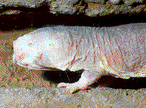

Ethiopian: Naked mole-rats are found only in parts of Kenya, Ethiopia and Somalia.
Mass: 25 to 70 g
Although as their name indicates, naked mole-rats do not have fur, they are not completely hairless. They have sensory whiskers on their faces and on their tails (they move both backwards and forwards through their tunnel systems), and they have hairs between their toes that allow their feet to function as brooms with which they sweep soil. Their skin is pink and somewhat translucent on the underside and light purplish brown on their backs and tails. This countershading appears to be lost with advanced age.
There is no sexual dimorphism between males and females. The queen and breeding males are generally among the heaviest individuals in a colony, and the queen is the longest individual. When a female becomes a queen she actually grows longer, even though she is already an adult, by increasing the distance between the vertebrae in her spine.
The small eyes of these subterranian animals are nearly sightless. They also have small ear pinnae, but their hearing is acute, as evidenced by their large repertoire of social vocalizations. Their sense of smell is very important, and they are also very sensitive to vibrations in the ground and the movement of air currents.
This diet is high in cellulose, which is difficult to digest. Naked mole-rats have high densities of gut fauna that aid in digestion. They also regularly practice coprophagy, the reingestion of feces, which allows them to maximize their uptake of nutrients from their food.
The duration of gestation is approximately 70 days. A queen can produce a new litter every 80 days, and can have up to 5 litters per year. Pups generally weigh less than 2 g at birth. The number of pups per litter is quite variable. The average is about 12, with a maximum of 27, the largest known litter size of any mammal. The queen nurses the pups for about 4 weeks, although they may begin eating solid food at as early as 2 weeks of age. Pups also eat feces that are provided for them on demand by the workers. This not only provides nutrition, it also innoculates their digestive system with beneficial gut fauna.
Pups begin performing work behaviors (digging, sweeping, carrying, etc.) at the age of 3 to 4 weeks. Maturation rate is variable, but in general juveniles are physiologically capable of reproduction by the age of one year. Maximum longevity in this species is as yet unknown, since animals that have been in captivity for as long as 20 years are still currently living. This life span is unprecedented among small rodents.
Naked mole-rats live in complex underground burrow systems. The tunnels are about 4 cm in diameter. Some tunnels run just under the surface of the ground, while others can be up to 2 m deep. There is a great deal of branching and interconnection of tunnels, with the result that a colony's total tunnel length can add up to 4 km. Tunnels connect nest chambers, toilet areas, and food sources. Burrowing is the only way these animals find food, since they do not travel above ground.
Workers dig through the hard-packed soil with their powerful ever-growing incisors, aided by the fact that 25% of an individual's muscle mass is involved in jaw closure. A mole-rat's lips actually close behind its incisors, such that it can dig without getting dirt in its mouth. They work assembly-line style, with the front animals actually breaking through the dirt while a string of workers sweeps the soil through the tunnel system to an opening to the surface, where another worker kicks the dirt up onto the ground above its head, forming a mole hill. Mole-rats seem to do the majority of a year's digging just after the rainy season, when the normally hard ground is softened.
These eusocial rodents also cooperate to thermoregulate. Unlike most other mammals, they cannot maintain a steady body temperature. Their temperatures fluctuate with the ambient temperature, making naked mole-rats essentially cold blooded. By huddling together in large masses, they slow their rate of heat loss. They also behaviorally thermoregulate by basking as needed in their shallow surface tunnels, which are warmed by the sun.
Status: no special status.
Although this unique animal has a limited geographic distribution, it can be quite numerous where it does occur.
A face only a queen could love.
Sherman, P.W., J.U.M. Jarvis, and R.D. Alexander, eds. 1991. The Biology of the Naked Mole-Rat. Princeton University Press, Princeton, New Jersey.
Click an image or name to view full size.
ASM Slide Library: J. Visser